Seminar: "Your Sustainable Backyard - Fruit Trees"
On what was supposed to be a hot Friday in August, I had the pleasure of participating in the first, hopefully annual, seminar presented by the California Center for Urban Horticulture, "Your Sustainable Backyard: Fruit Trees"
This event sold out very fast. I would guess that this is mainly due to the huge amount of interest in fruit that is happening right now, and partially because the event was held off of the Davis campus at the Wolfskill Experimental Orchards site in Winters.
Wolfskill is a 170 acre experimental station that U.C. Davis and USDA-ARS jointly occupy. Davis is doing breeding work there, and ARS keeps its fruit germplasm repository here. The draw here is that this site has been used by the University for over 80 years, and virtually no one has been allowed on site except for small, select groups. For example, about 15 years ago, the deciduous growers of CA held a meeting there to review some of the varieties in the repository for trueness to type, and none of us have been back since. Until now, that is.
Fruit Tasting
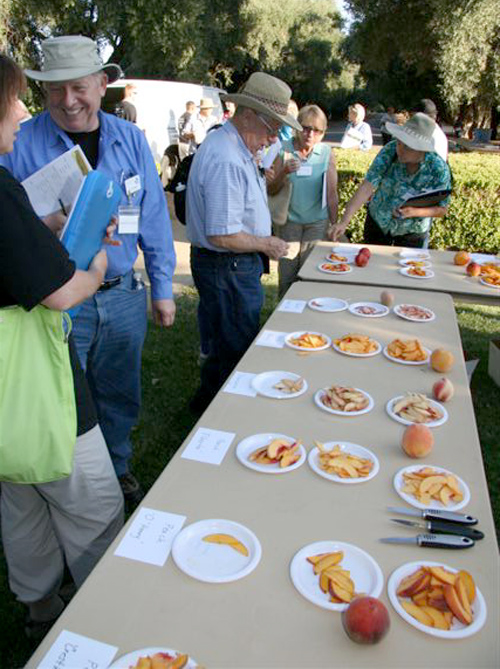
The day, which turned out to be temperature perfect in spite of all of the worry about heat, began in the cool of the morning with fruit tasting. I took some ripe-on-the-tree selections of peach (Champagne, Indian Blood Cling, Elberta) Elephant Heart Plum and Hosui Asian Pear. Champagne Peach was a real big hit.
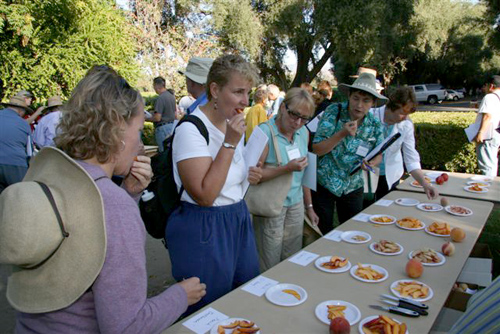
The Foundation Plant Service brought over some different selections of peaches and plums from their collection. We were also treated to some deliciously sweet European Plums (aka prunes), fresh off of the trees that the University is currently trialing for release as new patented varieties. Everyone had enough fruit to go around. There were also scones, but honestly, after the fruit, they just didn't do it for our group!
Hands On Training
There are really no classrooms or meeting rooms on the site, so we did a general meeting under the shade of some of the original trees that the Wolfskill family planted there in the 1850's. Hickory and a pecan that was 6' in diameter, and God only knows how high, because I couldn't see the top! That tree would have provided the entire group enough shade by itself, but the Hickories added the lower canopy shade to set it up perfectly. After a little history of the site, we broke into groups for in depth, hands on lessons by proven leaders within the university.
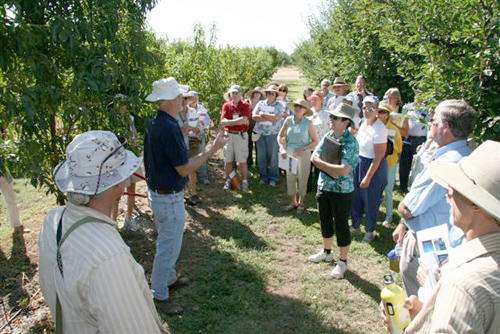
Outdoor Classroom
I went with the group that was going to learn about small space fruit production and summer pruning. This was taught by Ted DeJong, Professor of Pomology, who helped to develop the vase pruning techniques that are commonly used in orchards today, and Chuck Ingels, UC Co-operative Extension for Sacramento County. It was a perfect match of instructors as we soon found out.
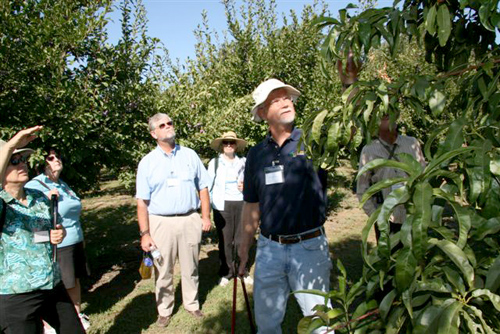
We started off by discussing what to do when you first get a tree from the nursery, either bare root or container, and what pruning should be done and why. While most of the audience were Master Gardeners, it was amazing to see how many were not exactly sure what to do when they get a tree. No wonder the EZ-Picks are so popular! We do the figuring out for you!
Ted Showing How to Prune a Young Tree
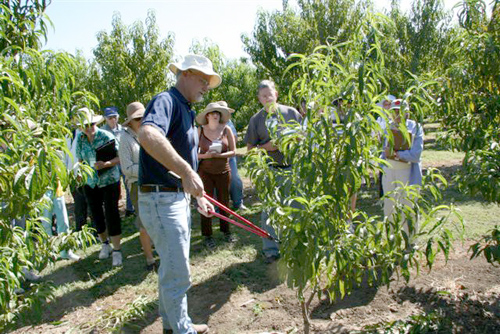
Multiple budded trees were then brought up, and Ted told the audience that his experience was that one or two would become dominant soon and choke out the others. I chimed in that this has mainly been our experience as well, but that Apples and Pears were easier to manage than stone fruits. Many in the audience also chimed in with similar frustrations. Ted then went through the concept of planting different varieties in a close space, like our 4-in-1 concept. This way, you get exactly what you want, and not what I picked out for you. More on 4-in-1 trees here: 4-in-1 Fruit Trees
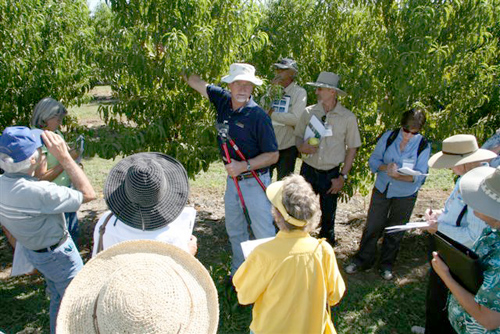
How to look for Water Shoots
Then we went hands on walking tour through the orchards. Ted showed us how to prune in 5 minutes, summer pruning, looking for water shoots that do not have spurs on them (where next year's fruit will be) and helping to keep the tree down in height, so you don't need a ladder for most of the fruit. He and Chuck went through this with several different types of trees, keeping it to where everyone in the group made sense of it, and we are all ready to go home and prune our trees better than ever! I have heard many lectures by some very distinguished horticulturalists over the years, and this was the most thorough talk I have ever been involved with. You learned the philosophy behind what you were doing, and then the how to do it as well, so you know why you are doing it and what you are doing. All in 30 minutes of walking through the orchard.
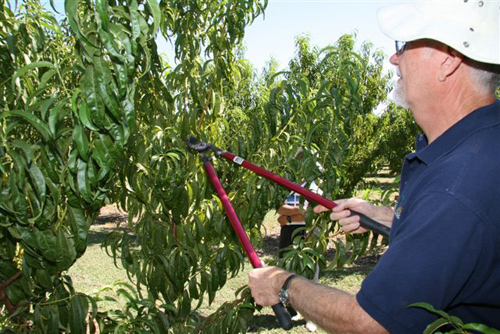
Dr. DeJong selects his cut
There was a separate talk at the same time on budding and grafting. I did not attend that. I thought that listening to the budding talk would make my knees hurt, as I have been on them plenty over the years making sure that our budders keep the buds as close to the ground as possible, to give you the best tree we can. Besides, they let everyone play with knives to try their own hand at the grafting, and I was afraid I would cut myself.
There was also a session on low impact pest management. The goal here was to help everyone understand that while there are a few things you have to watch on fruit, it is not a major issue to care for them. Typically, a dormant spray with a horticulture oil and a copper based spray will take care of most of the pest issues all year for the backyard farmer. Generally, the pests that are treated for commercially are not a big enough issue to bother the homeowner who is growing the fruit for a different purpose, to eat rather than ship.
The day was magnificent, and the discussions tremendous, and the new friends made and a couple of acquaintances re established made the event one of the more memorable of the year for me. David H. Cox
(Photos courtesy ofJohn Stumbos, U.C. Davis)

